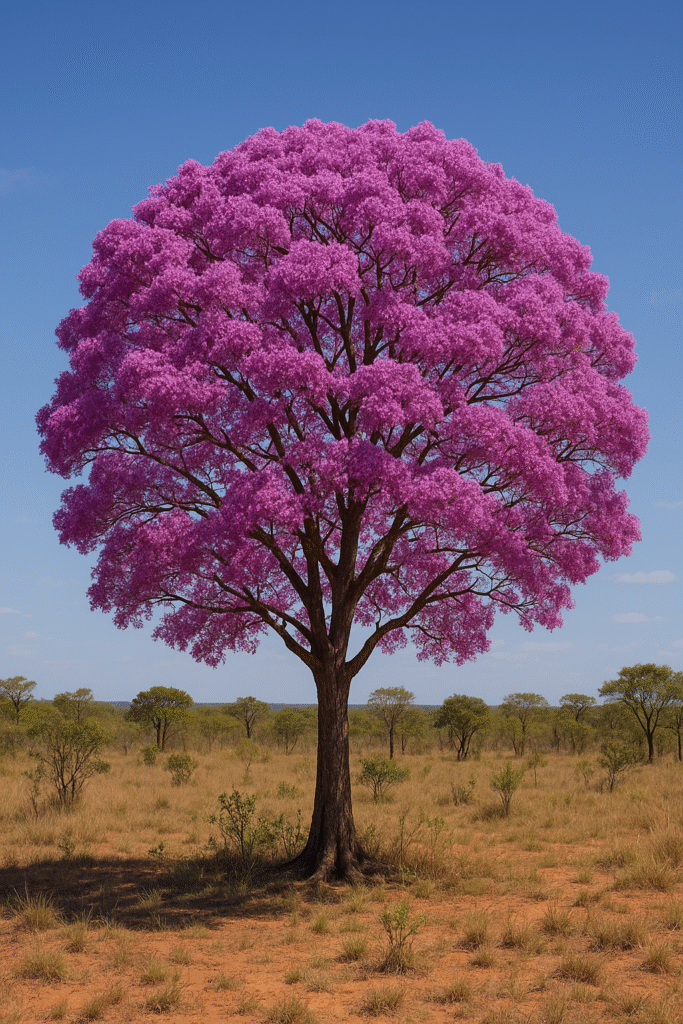The Purple Trumpet Tree (Handroanthus impetiginosus), also commonly known as the Pink Ipê, is one of the most iconic and admired trees of the Brazilian Cerrado. Despite being referred to as “purple,” its flowers often range from bright pink to deep magenta. During the dry season, this tree sheds all its leaves and bursts into colorful bloom, becoming a symbol of resilience and beauty in the savanna landscape.
1. Identification and Characteristics
- Height and shape: Typically reaches 8 to 20 meters in height, though it can grow up to 30 meters in denser forest areas.
- Leaves: Palmate compound leaves, usually with five leathery and glossy leaflets.
- Flowers: Trumpet-shaped, clustered at the ends of branches. Colors vary from light pink to dark magenta. Blooming occurs mainly between May and August, during the dry season.
- Fruits and seeds: Woody, elongated pods containing winged seeds, dispersed by wind. Seeds have a high germination rate and are used for reforestation.
2. Habitat in the Cerrado
Although native to several biomes, including the Atlantic Forest and Pantanal, the Purple Trumpet Tree thrives in the Cerrado, especially in gallery forests, cerradões (dense woodland savanna), and riparian areas. It prefers well-drained soils and is highly adapted to the Cerrado’s intense heat, periodic droughts, and natural fires.
3. Ecological Importance
- Pollination: Attracts bees, hummingbirds, and large insects like carpenter bees, contributing to local biodiversity and supporting pollinators.
- Fire resistance: The tree’s thick bark and deep root system help it withstand seasonal fires, making it ideal for restoration efforts in degraded areas.
- Soil enrichment: Its leaf litter improves soil quality, and its root system aids in stabilizing erosion-prone land.
4. Urban and Landscape Use
The Purple Trumpet Tree is widely planted in cities, parks, and gardens due to its ornamental value. Its large canopy offers shade, while its vibrant flowers create a spectacular visual during bloom.
Planting tips for urban areas:
- Ideal for parks, plazas, and wide sidewalks (minimum width: 2.5 meters).
- Avoid planting under power lines or in restricted spaces due to its size and root structure.
- Grows best in sunny spots with good soil drainage.
5. Timber and Commercial Uses
- High-value wood: The timber is dense, durable, and resistant to pests, decay, and humidity—making it a premium material for flooring, decks, fine furniture, and outdoor structures.
- Heaviness and durability: Often used for products requiring weight and resilience, such as tool handles and high-end carpentry items.
6. Medicinal and Traditional Uses
Known in folk medicine as “pau-d’arco,” the inner bark of the tree is used for its therapeutic properties. The bark contains lapachol, a compound with reported anti-inflammatory, antifungal, antibacterial, and antioxidant effects.
Common traditional uses:
- Infusions or teas to treat colds, flu, urinary infections, and skin issues.
- Used in natural medicine for rheumatism and digestive disorders.
- Scientific studies continue to evaluate its effectiveness and potential pharmacological applications.
7. Conservation and Genetics
The Purple Trumpet Tree is not currently considered endangered, but conservationists monitor its genetic diversity to ensure long-term viability. Remarkably, it was the first tree of the Cerrado biome to have its genome fully sequenced, a milestone that aids in understanding its adaptation, improving reforestation practices, and ensuring sustainable use.
8. Cultivation and Propagation
- Reproduction: Propagated easily by seeds with high germination rates.
- Soil and sunlight: Prefers full sun and moderately fertile, well-drained soil.
- Fertilization: Organic or slow-release fertilizers support strong growth and flowering.
- Watering: During the first year, watering helps establish the tree; after that, it’s drought-resistant.
- Pest resistance: Generally resilient but should be monitored in nursery settings.
Why Should You Plant a Purple Trumpet Tree?
| Reason | Benefit |
|---|---|
| Aesthetic appeal | Spectacular flowering display during the dry season, attracting visitors and admiration. |
| Environmental role | Supports pollinators and biodiversity; contributes to ecological restoration. |
| Economic value | Provides high-quality hardwood for the timber industry. |
| Medicinal use | Widely used in herbal remedies; backed by some scientific evidence. |
| Low maintenance | Hardy, drought-tolerant, and fire-adapted. |
| Cultural importance | Celebrated in Brazilian art, poetry, and folklore. |
Final Thoughts
The Purple Trumpet Tree of the Cerrado is more than just a beautiful tree—it’s an essential species for the Brazilian savanna. From its show-stopping blooms to its medicinal properties and ecological benefits, this tree symbolizes resilience, beauty, and sustainability.
Whether you’re planning a reforestation project, landscaping a garden, or just passionate about native flora, the Purple Trumpet Tree is a wise and rewarding choice. By planting it, you’re preserving biodiversity, supporting pollinators, and celebrating Brazil’s natural heritage.

Stay Dry, Travel Light!
Discover the Rainleaf Microfiber Towel – your perfect companion for travel, gym, camping, and more. Quick-dry, super absorbent, ultra-compact, and lightweight – ideal for beach, shower, pool, and backpacking adventures.
🛒 Get Yours Now on AmazonExplore the Giant of the Rainforest
Discover the fascinating story of the Xingu Brazil Nut Tree – a towering guardian of biodiversity in the Amazon. Learn its ecological importance, cultural significance, and role in sustaining life in the rainforest.
🌿 Read the Full Story
